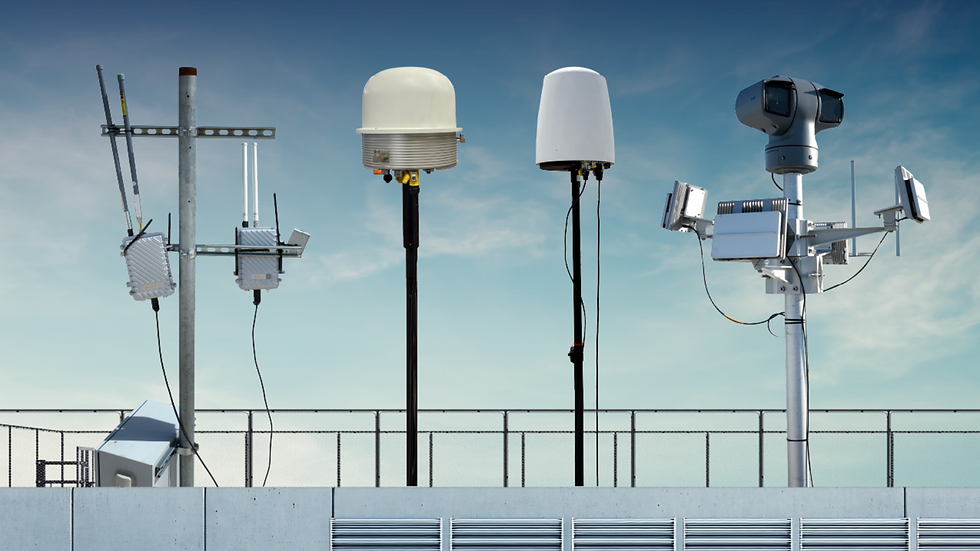Securing Critical Infrastructure Against Drone Threats
- LandSky.AI

- Aug 18
- 3 min read

Critical infrastructure such as power plants, data centers, airports, and communication hubs faces a growing risk that often flies under the radar: drones. Once limited to hobbyists, drones are now widely available, inexpensive, and increasingly capable. While most are used harmlessly, they can also be deployed for surveillance, disruption, or even attacks. For industries that keep the lights on and the economy
moving, that risk is too great to ignore.
The Drone Threat in Numbers
Since 2021, U.S. officials have tracked over 3,000 drone incidents near airports, with 11 cases in 2025 alone where aircraft had to take evasive action. Some resulted in collisions during emergency operations (Reuters).
In the second half of 2024, 27,000 drones were detected near the U.S. southern border, showing just how common unauthorized drone flights have become (Reuters).
U.S. Northern Command reported 350 drone incursions over more than 100 military bases in 2024, proving that even highly secured facilities are vulnerable (Wikipedia).
Overseas, Ukraine’s Operation Spiderweb used more than 100 inexpensive drones to inflict an estimated $7 billion in damage on Russian airbases, demonstrating how drones can multiply force when weaponized (Business Insider).
These figures make one thing clear: the threat is real, and it is scaling fast.
Why Critical Infrastructure is at Risk
The rise in incidents is fueled by three factors:
Accessibility: Consumer drones are affordable, easy to fly, and widely available.
Ambiguity: From the ground, it’s almost impossible to know whether a drone is flown by a hobbyist or a bad actor.
Limited defenses: Many facilities have strong ground-based security, but few have integrated tools to monitor or defend their airspace.
This creates gaps in coverage that can be exploited quickly and quietly.
Real-World Examples
Nations are already adapting. Ahead of the Paris Olympics, French authorities rolled out an ambitious anti-drone program. Security forces integrated radar, thermal cameras, and jammers to stop suspicious drones before they could disrupt stadiums or overfly nuclear plants (Le Monde).
In the United States, flight restrictions around critical zones have been expanded, yet enforcement remains difficult. Rules alone cannot stop a determined drone operator, and incidents around airports and stadiums continue to rise (Dragonfly Intelligence).
Detection and Defense: Two Layers of Protection
The most effective approach to countering drone threats involves both detection and active defense.
Drone Detection
Detects unauthorized drones entering restricted airspace.
Identifies drone type and flight pattern in real time.
Uses RF sensors, radar, and other technologies to give security teams early warning.
Creates audit trails that support regulatory compliance and incident response.
Active Defense (Jamming Capabilities)
Neutralizes drones once detected by disrupting their communication link or GPS guidance.
Provides a direct way to stop drones from gathering data, loitering, or interfering with operations.
Must be deployed carefully within regulatory frameworks, but is increasingly recognized as a necessary second layer of protection for critical sites.
Together, these two layers allow infrastructure operators not only to see the threat but also to act on it.
The Role of Automation and Robotics
Autonomous drones and robotic surveillance systems are the natural next step in strengthening these defenses. They offer:
Continuous coverage without fatigue.
AI-powered monitoring to classify drone activity and raise alerts automatically.
Seamless integration with existing ground-based security systems.
Scalability that reduces long-term operating costs compared to traditional guard deployments.
Instead of reacting after an incursion, operators can create a proactive security ecosystem where detection, defense, and monitoring work together.
Looking Ahead
Drone threats to critical infrastructure are not a passing challenge. They are growing in number and sophistication. The combination of drone detection and active defense technologies, backed by autonomous drone and robotic surveillance, gives operators a clear path to reduce exposure and strengthen resilience.
Organizations like LandSkyAI are working at the intersection of these solutions, helping clients integrate detection, monitoring, and autonomous patrols into a single, practical workflow. For critical infrastructure leaders, adopting this layered approach isn’t just about compliance — it’s about ensuring safety, reliability, and peace of mind in an increasingly complex security environment.
Interested in a live demo? Reach out to 📧 info@landsky.ai
Visit our website 🌐 www.landsky.ai



Comments